Rosh Hashanah, like most Jewish holidays, comes with lots to do. In addition to the usual holiday cooking, many also have a custom to prepare and enjoy simanim, or foods which serve as signs or symbols of our hopes and prayers for the new year. Here is a guide for how to prepare your simanim efficiently and deliciously!
Pomegranate
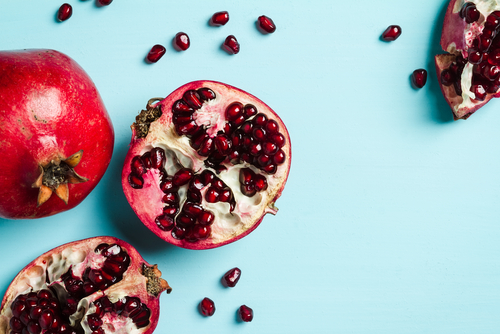
There are many ways to seed a pomegranate. The first method listed is slightly messier than the second one.
1. Water Method:
● Start by rolling your pomegranate around to free the seeds. Next, cut your pomegranate in half horizontally. Do this over a cutting board to avoid splatter. We recommend wearing gloves and an apron.
● Fill a bowl with cold water.
● Take one half of your pomegranate, and hold it seed side down over the water. Using a spoon, gently tap the back of the pomegranate half. The seeds should fall into the water. Repeat with the other half.
● Strain the seeds, rinse and enjoy!
2. Scoring Method:
● Start by scoring your pomegranate horizontally. Use a light hand when doing this, and make sure not to cut all the way through, as this will cause the seeds to burst.
● Use your hands to gently pry the pomegranate open. You should see that the seeds are completely intact. Set one half aside.
● Over a bowl, hold one pomegranate half (seed side down) in the palm of your hand. Gently tap the back of the pomegranate half using a spoon. The seeds should fall right out into the bowl. Rotate the pomegranate to be sure that you’re getting all of the seeds out. Repeat with the other half.
● Pick out any bits of pomegranate membrane, and enjoy!
Leek
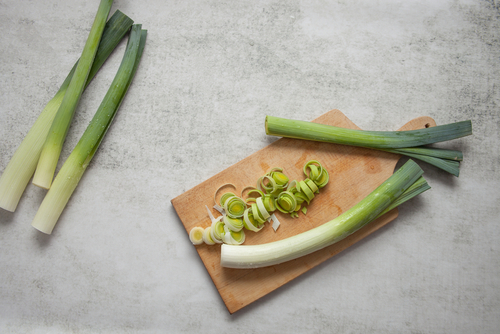
Insects can often lurk in leeks, so it’s important to be sure you are following a method that allows you to catch all of them. Here is how to check for bugs in leeks, according to the OU Manual for Checking Fruits and Vegetables:
● Cut leeks down their length from the top of the green shoot to the bottom of the bulb.
● If no insects are found, rinse under a powerful stream of running water.
Dates

It’s important to check your dates for worms. Here is how to do so, according to The OU Manual for Checking Fruits and Vegetables:
● Slice dates lengthwise, and examine their insides for worms. If worms are present, they are typically located on the inside of the date.
● If you are using pitted dates, no checking is necessary.
Squash
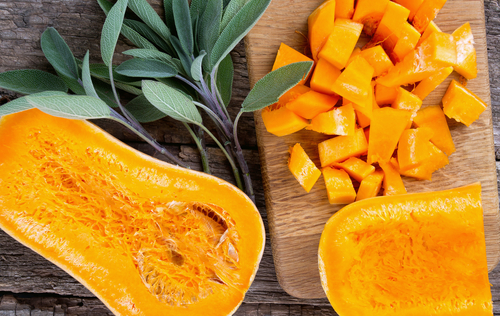
Squash is super soft after it’s cooked, but it’s pretty hard when it’s raw, which can make it difficult to cut and prepare. Here are some ideas for how to prepare your squash safely:
● Put your squash in the microwave for a few minutes before cutting. This will soften up the skin a bit and allow you to cut into the fruit with greater ease.
● If you don’t want to deal with cutting your squash (and we don’t blame you!), you can roast your squash whole. Just massage your squash with olive oil, sprinkle on some sea salt, cover with foil and roast on 350 degrees Fahrenheit until soft. This usually takes upwards of an hour, depending on how large your squash is.
This method works very well for spaghetti squash. Mix spaghetti squash with zoodles (zucchini noodles) for a delicious pasta-like dish. Top with sauce and additional sautéed vegetables. Yum!
● If you don’t want to use a microwave or roast your squash whole, you can cut your squash using this method:
1. Slice off the top and bottom of the fruit using a sharp knife to create a stable cutting surface. Cut the squash in half.
2. Use a spoon to remove the seeds and pulp. Peel skin if desired.
3. Place the cut sides down, and slice the squash. Cut into cubes if desired.
Carrots
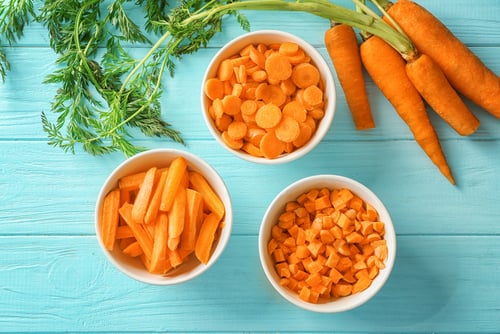
Carrots can be enjoyed and prepared in so many ways! Here are some of our favorites:
● Peel your carrots in a cool way to make them more exciting. We absolutely love this thin peeler, which you can use to make carrot ribbons.
●Did you know that you can peel carrots using a spoon? Check out this Youtube video to see how to do it. If you want to involve younger kids in the cooking process, it can be fun to let them try out this safer peeling method.
Beets
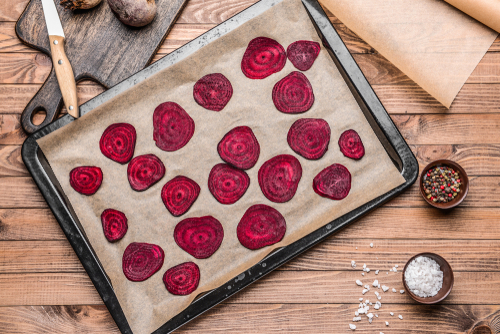
Preparing beets can be a hassle, since their pink juice seems to get everywhere. Here are some tips for how to prepare your beets and for how to avoid a long cleanup:
● Wear gloves and an apron when cutting beets. Be sure to use a cutting board as well.
● After beets are roasted, they usually aren’t as messy as they are when they’re raw. To roast them, slice beets thinly and roast on 425 degrees Fahrenheit with olive oil, salt, and pepper until soft (about 40 minutes).
● Beets can be eaten raw. Raw beets taste great shredded into a salad with carrots and cucumbers. Make a vinaigrette with seasoned rice vinegar, olive oil, everything seasoning, salt and pepper for an easy, refreshing salad.
● There are a variety of beets to choose from – golden, candy cane, red – feel free to mix things up!
Black-Eyed Peas
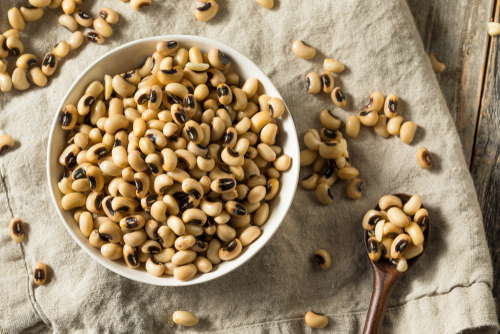
Instead of buying dry beans and soaking them for hours, a faster alternative is canned beans. Whole Foods and Eden Organic both sell kosher canned black eyed peas. Here are some ideas for how to prepare your peas:
● Prepare mini tacos with guacamole and/or salsa. This is very easy to do if you buy canned beans. Just drain and rinse the beans, insert them into the tacos with the desired toppings, and you’re good to go! Your kids will love these!
● Another option is to sauté the beans with onions and garlic to give them some extra flavor.
Apples
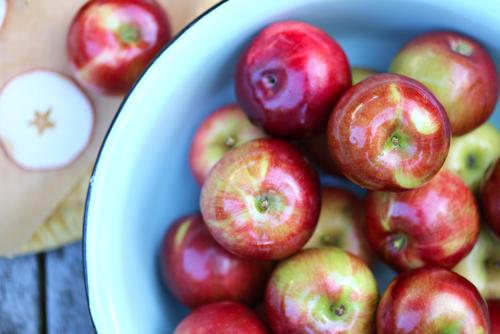
It wouldn’t be Rosh Hashanah without some delicious snacking apples. Some of our favorite apple varieties to munch on include Honeycrisp, McIntosh, Cameo, Jonagold and Winesap.
This apple cobbler recipe is also a great way to use your apples.
Fish Head
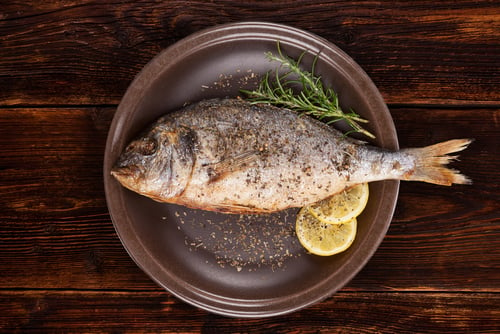
Start your year on the right foot – well, actually, with the right head! Here is how we recommend preparing your fish head(s):
Cook your fish in a tin lined with parchment paper to make the cleanup easier. We recommend this simple recipe:
● Preheat oven to 400 degrees Fahrenheit. Cut fish heads in half.
● Season with salt and pepper.
● Bake for about 15 minutes. Cooking time will vary depending on the size of the fish heads.
To keep your home smelling fresh while you’re baking the fish, we recommend lighting a candle or plugging in a diffuser while cooking.
——————————-
We hope this article showed you how to best prepare your simanim. Do you have any tips or tricks for preparing simanim? Please share your secrets in the comments below! Wishing you and your family a meaningful holiday and year ahead.
Once you have your simanim prepped and ready, check out these creative ideas of ways to present these symbolic foods!





